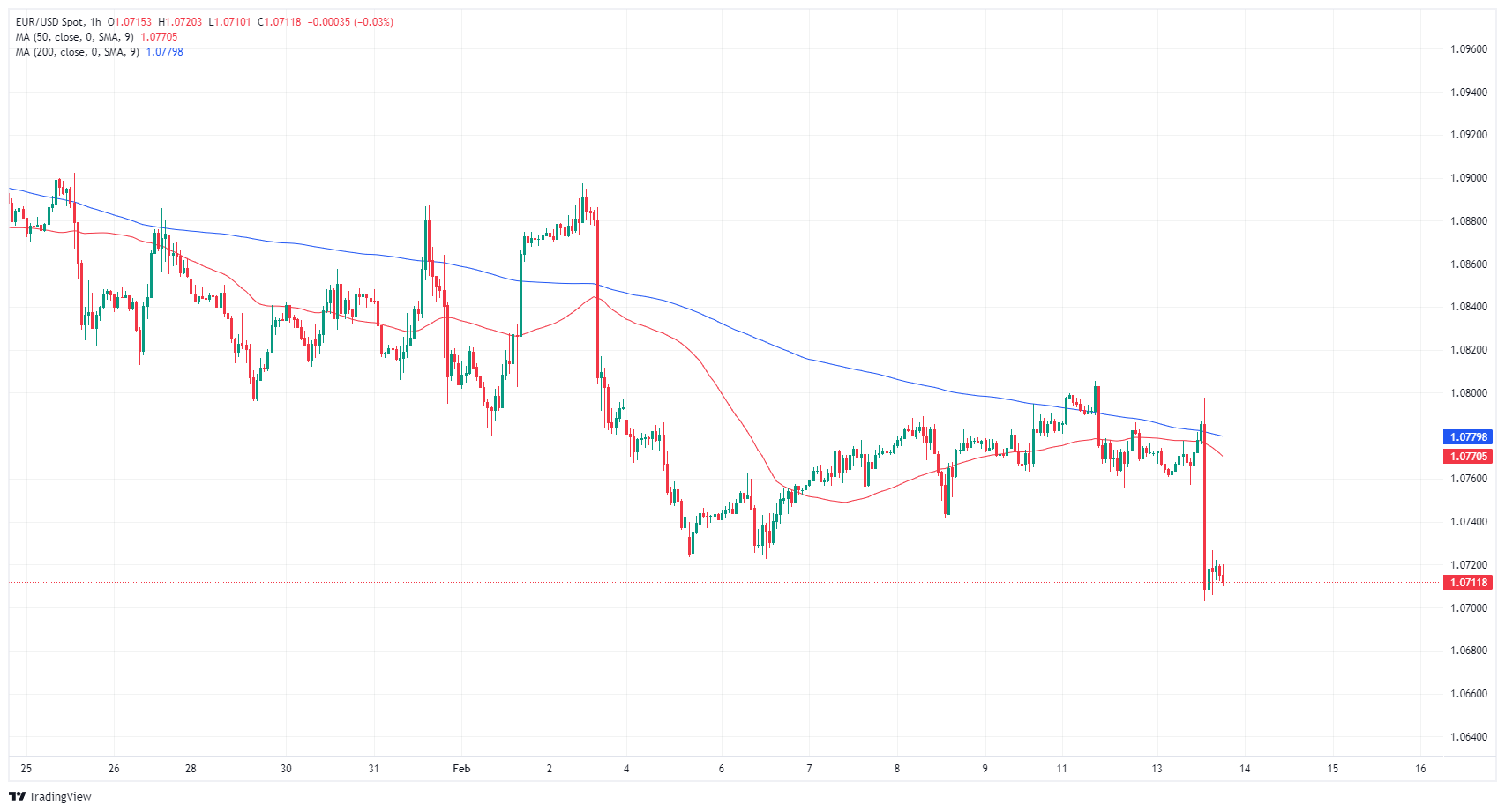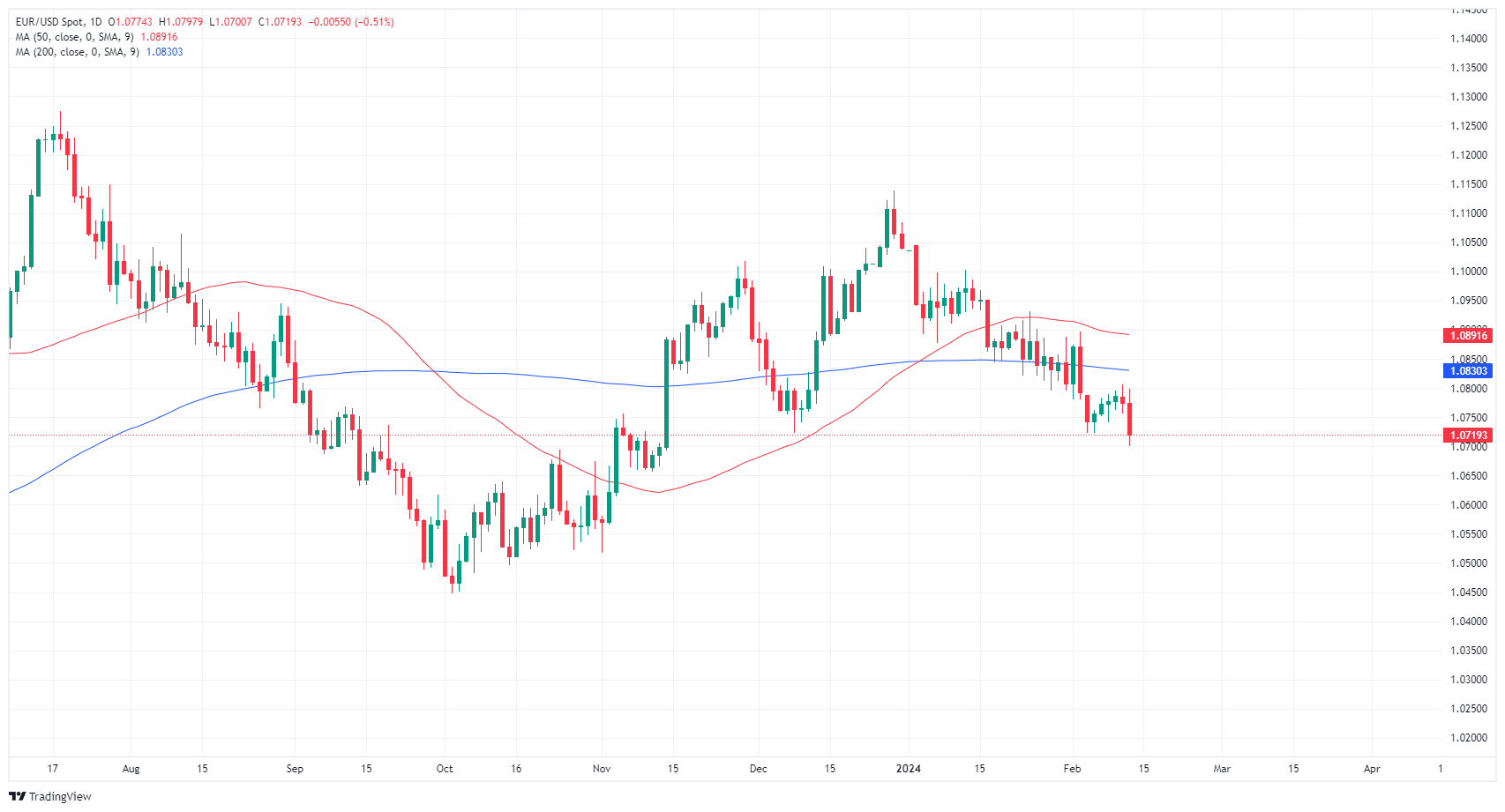- Phân tích
- Tin tức và các công cụ
- Tin tức thị trường
- EUR/USD plunged towards 1.0700 after US CPI inflation came in hot
EUR/USD plunged towards 1.0700 after US CPI inflation came in hot
- EUR/USD dipped into multi-week lows after an unexpected uptick in US CPI inflation.
- European February ZEW Economic Sentiment Survey improved.
- European GDP growth, US Retail Sales in the pipe for the midweek.
EUR/USD tumbled 0.9% on Tuesday after US Consumer Price Index (CPI) inflation came in above market expectations. Money markets’ expectations of rate cuts from the Federal Reserve (Fed) got knocked back as US inflation proves stickier than investors were hoping for.
Europe saw a slight improvement in the ZEW Economic Sentiment Survey for February, and Euro (EUR) traders will be gearing up for European Gross Domestic Product (GDP) figures due on Wednesday. Thursday will follow up with more US economic data with US Retail Sales expected to slow in January.
Daily digest market movers: EUR/USD gets a sharp rebalance on safe-haven flows into US Dollar
- MoM US CPI inflation ticked up to 0.3% in January versus the forecast 0.2%.
- December’s monthly CPI saw a slight revision down from 0.3% to 0.2%.
- Core MoM CPI also ticked up to 0.4% from the forecast steady hold of 0.3%.
- Annualized headline CPI inflation printed at 3.1%, above the forecast 2.9% but still easing slightly from the previous period’s 3.4%.
- Money markets are now pricing in a first rate cut from the Fed in June or July after getting knocked off of a March rate trim bet.
- The euro area ZEW Economic Sentiment survey for February improved to 25.0 from the previous 22.7, reversing the forecast decline to 20.1.
- Wednesday’s European GDP is expected to hold flat at 0.0% for the fourth quarter.
- Annualized European quarterly GDP is forecast to hold steady at a scant 0.1%.
- European Central Bank (ECB) President Christine Lagarde makes an appearance early Thursday.
- ECB President Lagarde will be testifying before the European Parliament’s Committee on Economic and Monetary Affairs in Brussels.
- Thursday also sees US Retail Sales, and investors are hoping for January’s retail activity to tick down -0.1% versus the previous month’s 0.6%.
Euro price today
The table below shows the percentage change of Euro (EUR) against listed major currencies today. Euro was the strongest against the Swiss Franc.
| USD | EUR | GBP | CAD | AUD | JPY | NZD | CHF | |
| USD | 0.59% | 0.30% | 0.95% | 1.20% | 0.92% | 1.24% | 1.26% | |
| EUR | -0.60% | -0.29% | 0.35% | 0.62% | 0.33% | 0.65% | 0.68% | |
| GBP | -0.31% | 0.28% | 0.65% | 0.90% | 0.61% | 0.94% | 0.96% | |
| CAD | -0.95% | -0.36% | -0.64% | 0.24% | -0.03% | 0.30% | 0.32% | |
| AUD | -1.22% | -0.62% | -0.91% | -0.25% | -0.29% | 0.04% | 0.09% | |
| JPY | -0.92% | -0.31% | -0.61% | 0.02% | 0.31% | 0.33% | 0.35% | |
| NZD | -1.26% | -0.67% | -0.95% | -0.29% | -0.04% | -0.33% | 0.01% | |
| CHF | -1.31% | -0.71% | -1.00% | -0.33% | -0.12% | -0.38% | -0.05% |
The heat map shows percentage changes of major currencies against each other. The base currency is picked from the left column, while the quote currency is picked from the top row. For example, if you pick the Euro from the left column and move along the horizontal line to the Japanese Yen, the percentage change displayed in the box will represent EUR (base)/JPY (quote).
Technical analysis: EUR/USD falls into multi-week lows, approaches 1.0700
EUR/USD tumbled on Tuesday, knocking into eight-week lows and coming with reach of 1.0700 as the pair continues to drift into the bearish side. The EUR/USD saw a sharp technical rejection of the 200-hour Simple Moving Average (SMA) near 1.0780 early Tuesday. Previous technical support at the 1.0725 turnaround zone is poised to form a near-term technical ceiling for bullish recoveries.
The EUR/USD continues to drift into deeper bear country below the 200-day SMA near 1.0830, and continued downside momentum below 1.0700 sets the pair up for an extended slide into last October’s lows near 1.0450.
EUR/USD hourly chart
EUR/USD daily chart
Euro FAQs
What is the Euro?
The Euro is the currency for the 20 European Union countries that belong to the Eurozone. It is the second most heavily traded currency in the world behind the US Dollar. In 2022, it accounted for 31% of all foreign exchange transactions, with an average daily turnover of over $2.2 trillion a day.
EUR/USD is the most heavily traded currency pair in the world, accounting for an estimated 30% off all transactions, followed by EUR/JPY (4%), EUR/GBP (3%) and EUR/AUD (2%).
What is the ECB and how does it impact the Euro?
The European Central Bank (ECB) in Frankfurt, Germany, is the reserve bank for the Eurozone. The ECB sets interest rates and manages monetary policy.
The ECB’s primary mandate is to maintain price stability, which means either controlling inflation or stimulating growth. Its primary tool is the raising or lowering of interest rates. Relatively high interest rates – or the expectation of higher rates – will usually benefit the Euro and vice versa.
The ECB Governing Council makes monetary policy decisions at meetings held eight times a year. Decisions are made by heads of the Eurozone national banks and six permanent members, including the President of the ECB, Christine Lagarde.
How does inflation data impact the value of the Euro?
Eurozone inflation data, measured by the Harmonized Index of Consumer Prices (HICP), is an important econometric for the Euro. If inflation rises more than expected, especially if above the ECB’s 2% target, it obliges the ECB to raise interest rates to bring it back under control.
Relatively high interest rates compared to its counterparts will usually benefit the Euro, as it makes the region more attractive as a place for global investors to park their money.
How does economic data influence the value of the Euro?
Data releases gauge the health of the economy and can impact on the Euro. Indicators such as GDP, Manufacturing and Services PMIs, employment, and consumer sentiment surveys can all influence the direction of the single currency.
A strong economy is good for the Euro. Not only does it attract more foreign investment but it may encourage the ECB to put up interest rates, which will directly strengthen the Euro. Otherwise, if economic data is weak, the Euro is likely to fall.
Economic data for the four largest economies in the euro area (Germany, France, Italy and Spain) are especially significant, as they account for 75% of the Eurozone’s economy.
How does the Trade Balance impact the Euro?
Another significant data release for the Euro is the Trade Balance. This indicator measures the difference between what a country earns from its exports and what it spends on imports over a given period.
If a country produces highly sought after exports then its currency will gain in value purely from the extra demand created from foreign buyers seeking to purchase these goods. Therefore, a positive net Trade Balance strengthens a currency and vice versa for a negative balance.
© 2000-2024. Bản quyền Teletrade.
Trang web này được quản lý bởi Teletrade D.J. LLC 2351 LLC 2022 (Euro House, Richmond Hill Road, Kingstown, VC0100, St. Vincent and the Grenadines).
Thông tin trên trang web không phải là cơ sở để đưa ra quyết định đầu tư và chỉ được cung cấp cho mục đích làm quen.
Giao dịch trên thị trường tài chính (đặc biệt là giao dịch sử dụng các công cụ biên) mở ra những cơ hội lớn và tạo điều kiện cho các nhà đầu tư sẵn sàng mạo hiểm để thu lợi nhuận, tuy nhiên nó mang trong mình nguy cơ rủi ro khá cao. Chính vì vậy trước khi tiến hành giao dịch cần phải xem xét mọi mặt vấn đề chấp nhận tiến hành giao dịch cụ thể xét theo quan điểm của nguồn lực tài chính sẵn có và mức độ am hiểu thị trường tài chính.
Sử dụng thông tin: sử dụng toàn bộ hay riêng biệt các dữ liệu trên trang web của công ty TeleTrade như một nguồn cung cấp thông tin nhất định. Việc sử dụng tư liệu từ trang web cần kèm theo liên kết đến trang teletrade.vn. Việc tự động thu thập số liệu cũng như thông tin từ trang web TeleTrade đều không được phép.
Xin vui lòng liên hệ với pr@teletrade.global nếu có câu hỏi.















